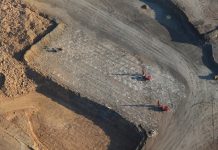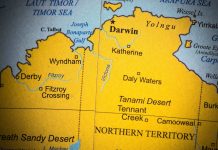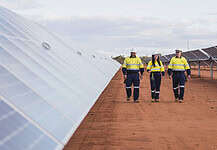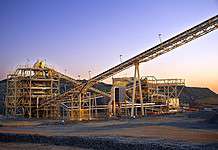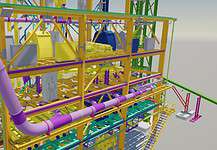 CHINESE iron ore imports surged in September despite widespread predictions of weakening demand and a looming supply glut. Chinese customs data, released mid-October, revealed imports of 74.6 million tonnes were an all-time high, up 8 per cent on August figures and 15 per cent on the same period last year. The country continued to produce steel at record levels of about 2.14mt each day – almost as much as the rest of the world combined – which was a boon for the reinvigorated Australian iron ore sector. While the solid reports and record-breaking production volumes of iron ore heavyweights Rio Tinto, BHP Billiton and Fortescue Metals Group received much of the spotlight, Perth-based Mount Gibson Iron quietly reported one of its strongest quarters to date.
CHINESE iron ore imports surged in September despite widespread predictions of weakening demand and a looming supply glut. Chinese customs data, released mid-October, revealed imports of 74.6 million tonnes were an all-time high, up 8 per cent on August figures and 15 per cent on the same period last year. The country continued to produce steel at record levels of about 2.14mt each day – almost as much as the rest of the world combined – which was a boon for the reinvigorated Australian iron ore sector. While the solid reports and record-breaking production volumes of iron ore heavyweights Rio Tinto, BHP Billiton and Fortescue Metals Group received much of the spotlight, Perth-based Mount Gibson Iron quietly reported one of its strongest quarters to date.
Mount Gibson celebrated the second highest iron-ore sales in its history in the September quarter, as the company boosted production from its historic Koolan Island operations in WA. Reported sales of 2.6 million metric tonnes in the three months through September were a 13 per cent improvement on the previous quarter, and just shy of the record 2.7mt sold in the three months through December. Mount Gibson chief executive Jim Beyer said the company expected sales of between 9 and 9.5mt in the fiscal year through June, in line with previous guidance.
“Mount Gibson has made an excellent start to the 2014 financial year, achieving our second best ever quarterly sales result, which together with robust iron ore prices and our ongoing focus on cost reductions, has seen us maintain our record of strong cash generation,” he said.
Operations
Koolan Island
Mount Gibson’s outstanding quarterly sales performance of 2.6mt included impressive figures from its Koolan Island operation, about 140km north of Derby in Yampi Sound, off the northern Kimberley coast of WA. The company is moving to ramp up production at the historic operations from 3 million tonnes per annum to 4mtpa by the end of 2014.
As the planned ramp up progressed through the September quarter, total material movement and ore production increased significantly: waste movement by 51 per cent to 6mt, and ore production more than sixfold to 863,000t compared with the June quarter. Ore shipments totalling 1.075mt were 86 per cent higher than the preceding quarter, and by the end of the quarter crushed direct shipping ore (DSO) stockpiles and uncrushed DSO stockpiles totalled 66,000t and 191,000t respectively.
Mount Gibson reported that Koolan’s average unit cash mining costs for the quarter remained at the lower end of guidance, and the company was “extremely encouraged” that cost improvements continued to be achieved. Furthermore, labour productivity improvements during the period resulted in a 25 per cent improvement in total tonnes moved per man hour in September, compared to the June quarter. Construction of a new workshop was completed, with final fit-out and the transfer of workshop operations underway, while the centralised administration facility would be operational before the end of the December quarter.
“It is particularly satisfying to see continued rapid improvement at our Koolan Island operation as the ramp up to 4mtpa gathers momentum, delivering significant productivity and cost gains,” Mr Beyer said.
Mid West Operations
Total sales of 1.5mt from Mount Gibson’s’ Extension Hill and Tallering Peak mines represented the second best quarterly sales performance achieved by the company’s Mid West operations. In light of the tidal-surge conditions that plagued Geraldton Port for about two weeks during September, its volume of ore shipments – 1.4mt – was also a strong result.
In addition to shipments from Geraldton Port, Mount Gibson completed mine-gate sales to a third party of 160,000t of DSO from Extension Hill during the quarter, made possible through a short-term opportunity to utilise available third party rail capacity in excess of the company’s allocated train paths from the Perenjori rail siding.
“The continuing strong performance of our Mid West operations keeps us well on track to achieve our full year sales target of 9 to 9.5mt this financial year, in line with guidance,” Mr Beyer said. Production at the low-cost, high-return Extension Hill hematite project in the Mount Gibson Ranges, 260km southeast of Geraldton, began in December 2011. In the September quarter, it achieved total sales of 749,000t — its second best quarterly sales result — while ore mining rocketed 50 per cent on the previous quarter.
After 10 years of operation Tallering Peak was scheduled for closure in mid-2013. Then, in March this year, the company announced a maiden indicated and inferred resource for the T1 deposit – 1km east of the current T6 main pit – of 1.4mt grading 60.4 per cent iron. By September, first ore production was underway.
Mount Gibson stated that the development of T1 would result in total ore sales of about 2.5mt from the operation in financial year 2014, including sales of about 700,000t of stockpiled lower grade ore. Further pit optimisation work would extend mining in the operating T6 pit to January 2014, with all ore sales from Tallering Peak – including T1 and the lower grade ore stockpile – expected to be concluded in mid 2014.
Mount Gibson chief executive Jim Beyer said the development of T1 was indicative of the company’s ability to extract maximum value from its existing operations while also focussing on long term growth.
“Exploiting the T1 deposit will deliver additional value to Mount Gibson from what has already been a highly successful investment since production at Tallering Peak commenced in late 2003,” he said. “It also demonstrates our ongoing commitment to the Mid West region, where we have invested heavily in strategic export capacity and are targeting opportunities that will complement our Extension Hill hematite operation so that we remain a substantial producer in the region for many years to come.”
Exploration and development
Despite Koolan Island’s long mining history – BHP mined almost 70mt of high-grade iron ore between 1959 and 1993 – exploration upside remains. Extensive mapping and rock chip sampling across a number of prospective targets on the West End of Koolan Island in the September quarter were correlated with drill intercepts from a 2011 program. Mount Gibson reported that new drilling to test viable targets would kick off after the end of the wet season during the first half of 2014. Early stage exploration activities are already underway at Koolan South, a tenement covering 230 square kilometres on the mainland directly south of Koolan Island.
Mount Gibson stated that it considered the Extension Hill South area “to have the most exciting near mine exploration potential for iron ore in the Mid West”, based on detailed reviews of past exploration data from the area immediately south of the Extension Hill open pit.
On 23 September, the WA Department of Mines and Petroleum approved a Program of Work for an initial drilling program at Extension Hill South, with drilling scheduled to start at the Iron Hill prospect in November 2013. “Surface mapping and historical drilling results indicate the area has high potential to host economic hematite which could extend the Extension Hill mine life,” the company reported.
The 250sqkm Field’s Find project area is 160km north of Extension Hill mine, and includes the Plateau iron prospect, the historic Baron Rothschild and Fields Find gold camps and the abandoned Warriedar copper mine. After receiving heritage consent and DMP drilling approval in September, initial drilling of the Plateau prospect – where a number of significant iron intercepts were recorded by a previous operator – started mid-October.
“It was very pleasing to receive drilling approvals late in the quarter for both our Extension Hill South and Field’s Find projects, which we believe have significant potential to add to our Mid West resource base,” Mr Beyer said.
A strong cash position
Mount Gibson’s record-breaking quarter was indicative of its strong showing across the current year. The company’s production successes have placed it in an enviable financial position, with cash and term deposits of $420 million ($0.385 per share) at 30 September, compared with $376 million at 30 June. For the 2013 financial year, the company reported net profit after tax of $157.3 million, with minimal debt.
Mount Gibson has continued to evaluate opportunities to complement its existing businesses, as part of its longer term growth strategy. “The near term focus of this evaluation process is on identifying suitable opportunities in the Mid West region, where its existing processing and infrastructure footprint gives the company a strategic competitive advantage,” the company reported.
“Mount Gibson made several exploration licence applications in the Mid West in the June quarter and continues to monitor and peg prospective ground.” The company also continues to assess broader long term growth opportunities in bulk carbon steel materials, primarily focussed on iron ore and coking coal.

